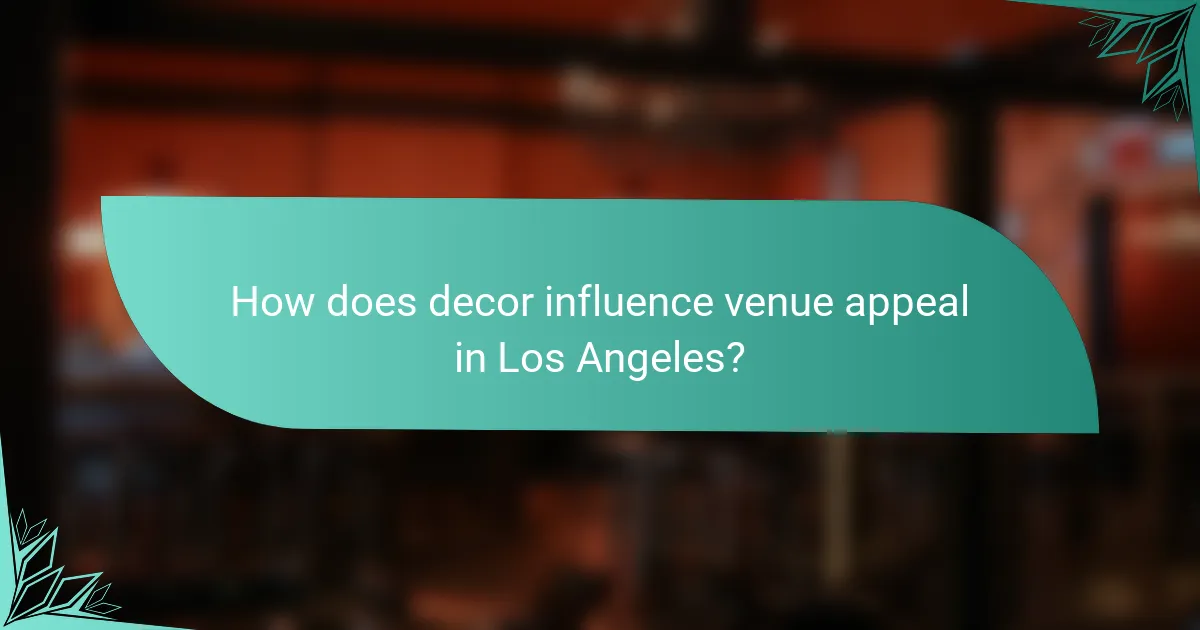Decor plays a vital role in shaping the appeal of venues, particularly in vibrant cities like Los Angeles. By creating inviting atmospheres and resonating with target audiences, effective decor strategies can enhance customer experiences and perceptions, ultimately contributing to a venue’s success.

How does decor influence venue appeal in Los Angeles?
Decor plays a crucial role in enhancing the overall appeal of venues in Los Angeles by creating an inviting atmosphere that attracts visitors. Thoughtfully designed spaces can significantly impact customer perceptions and experiences, making decor a key factor in venue success.
Enhances aesthetic value
The aesthetic value of a venue is often the first impression it makes on potential customers. In Los Angeles, where visual appeal is paramount, decor that reflects local culture and trends can elevate a venue’s attractiveness. For example, incorporating vibrant colors, unique art pieces, and stylish furniture can create an inviting ambiance that resonates with the city’s artistic spirit.
When selecting decor, consider the theme and purpose of the venue. A trendy bar might benefit from modern, sleek designs, while a family restaurant could opt for warm, cozy decor. Aligning the aesthetic with the target audience enhances the overall experience and encourages repeat visits.
Creates memorable experiences
Memorable experiences are often tied to the decor of a venue, as it sets the mood and tone for gatherings. In Los Angeles, where events and social outings are common, unique decor can leave a lasting impression on guests. For instance, themed decorations for special events can create a sense of occasion that guests will remember long after they leave.
To create memorable experiences, consider incorporating interactive elements, such as photo walls or immersive installations, that encourage guests to engage with the space. This not only enhances their enjoyment but also promotes social sharing, further increasing the venue’s visibility.
Increases customer engagement
Effective decor can significantly boost customer engagement by creating inviting spaces that encourage interaction. In Los Angeles, venues that feature comfortable seating arrangements and visually appealing decor can foster social connections among guests. This engagement can lead to longer visits and increased spending.
To maximize customer engagement, ensure that the decor facilitates movement and conversation. Open layouts, strategically placed decor, and cozy nooks can enhance the social atmosphere. Additionally, consider seasonal updates to the decor to keep the space fresh and encourage repeat visits from locals and tourists alike.

What are effective decor strategies for local venues?
Effective decor strategies for local venues focus on creating an inviting atmosphere that resonates with the target audience. By utilizing theme-based decor, seasonal decorations, and interactive installations, venues can enhance their appeal and create memorable experiences for guests.
Theme-based decor
Theme-based decor involves designing the venue around a specific concept or idea, which can significantly enhance the guest experience. For example, a rustic theme might include wooden accents, vintage furniture, and warm lighting, while a modern theme could feature sleek lines and minimalist decor.
When implementing a theme, consider the venue’s purpose and the audience’s preferences. Ensure that all elements, from furniture to table settings, align with the chosen theme to create a cohesive look. Avoid overwhelming guests with too many competing styles.
Seasonal decorations
Seasonal decorations allow venues to refresh their look throughout the year, keeping the environment dynamic and engaging. For instance, autumn might bring in warm colors and natural elements like pumpkins, while spring could feature bright flowers and pastel colors.
To effectively use seasonal decor, plan ahead and allocate a budget for decorations that can be easily stored and reused. Consider local cultural events and holidays to align decorations with community interests, enhancing relevance and connection.
Interactive installations
Interactive installations engage guests and encourage participation, making the venue more memorable. Examples include photo booths, art walls where guests can contribute, or even digital displays that respond to guest interactions.
When incorporating interactive elements, ensure they are easy to use and accessible to all guests. Monitor the installations for maintenance and cleanliness, as these factors can significantly impact the overall experience. Aim for installations that reflect the venue’s theme and enhance the atmosphere without causing clutter.

How can decor impact customer perceptions?
Decor significantly influences how customers perceive a venue, shaping their overall experience and satisfaction. Thoughtfully designed spaces can enhance brand identity, evoke specific moods, and affect how customers value the offerings.
Shapes brand identity
Decor plays a crucial role in defining a brand’s identity by visually communicating its values and personality. For example, a luxury restaurant may use elegant furnishings and soft lighting to convey sophistication, while a casual cafe might opt for vibrant colors and eclectic decor to create a welcoming atmosphere.
Consistency in decor across all customer touchpoints reinforces brand recognition. Businesses should ensure that their decor aligns with their branding strategy, using elements like color schemes, materials, and styles that resonate with their target audience.
Influences mood and comfort
The right decor can significantly influence customers’ moods and comfort levels. Warm colors and soft textures can create a cozy environment, encouraging patrons to linger longer, while bright colors and modern designs may energize and stimulate conversation.
Consider the layout and furniture arrangement as well; open spaces with comfortable seating can promote relaxation, while cramped, cluttered areas may lead to discomfort. Businesses should assess their decor regularly to ensure it meets the desired emotional impact on customers.
Affects perceived value
Customers often associate decor quality with the overall value of a venue. High-quality materials and well-thought-out design can elevate perceived value, leading customers to justify higher prices for products or services. For instance, a boutique hotel with luxurious decor may charge premium rates compared to a similarly priced competitor with basic furnishings.
To enhance perceived value, businesses should invest in decor that reflects their brand positioning. Regular updates and maintenance of decor can also prevent a decline in perceived value, ensuring that customers continue to view the venue as a worthwhile destination.

What are the costs associated with venue decor?
The costs associated with venue decor can vary significantly based on the type of event, the scale of decoration, and the materials used. Key cost categories include initial setup costs, ongoing maintenance expenses, and seasonal refresh costs, each of which plays a crucial role in budgeting for decor.
Initial setup costs
Initial setup costs encompass all expenses incurred to create the desired aesthetic for an event. This may include purchasing or renting items such as furniture, lighting, floral arrangements, and decorative elements. Depending on the venue size and complexity, these costs can range from a few hundred to several thousand dollars.
When planning for initial setup, consider whether to buy or rent decor. Renting can often be more cost-effective for one-time events, while purchasing may be beneficial for venues hosting frequent events.
Ongoing maintenance expenses
Ongoing maintenance expenses refer to the costs associated with keeping the decor in good condition over time. This includes cleaning, repairs, and replacements of damaged items. Regular maintenance can help preserve the quality and appearance of decor, which is essential for venues that host events frequently.
Budgeting for ongoing maintenance should account for factors such as the type of materials used and the frequency of events. For example, venues with high foot traffic may require more frequent upkeep, leading to higher costs.
Seasonal refresh costs
Seasonal refresh costs involve updating decor to reflect different seasons or themes throughout the year. This can include changing floral arrangements, adding seasonal decorations, or swapping out furniture covers. These costs can vary widely based on the extent of the refresh and the materials chosen.
To manage seasonal refresh costs effectively, consider creating a schedule for updates and budgeting accordingly. This approach allows for strategic planning and can help avoid last-minute expenses that may arise from unplanned changes.

What permits are required for decor installations in Los Angeles?
In Los Angeles, various permits are necessary for decor installations, depending on the type and scale of the project. Understanding these requirements helps ensure compliance with local regulations and avoids potential fines or delays.
Building permits
Building permits are essential for any structural changes or installations that affect the integrity of a building. This includes significant decor elements like large fixtures or alterations to walls. To obtain a building permit, you typically need to submit detailed plans and specifications to the Los Angeles Department of Building and Safety.
Consider that the cost of building permits can vary widely, often ranging from a few hundred to several thousand dollars based on the project’s complexity. Always check the latest regulations and fees before starting your project.
Special event permits
Special event permits are required for temporary decor installations associated with events such as weddings, festivals, or corporate gatherings. These permits ensure that the event complies with safety and zoning laws. The application process usually involves submitting an event plan that outlines the decor setup, expected attendance, and duration of the event.
For events in public spaces, you may need to apply for additional permits from the city or local authorities. Fees for special event permits can vary, so it’s advisable to apply well in advance to avoid last-minute complications.
Signage permits
Signage permits are necessary if your decor includes any form of signage, such as banners or promotional displays. These permits ensure that the signage adheres to local zoning laws and aesthetic guidelines. The application process typically requires a description of the signage, its dimensions, and its intended location.
In Los Angeles, signage permits can take time to process, so plan accordingly. Fees can vary based on the size and type of signage, so it’s wise to consult the city’s guidelines to understand the specific requirements and costs involved.

How can venues measure the impact of decor on business?
Venues can measure the impact of decor on business through various methods, primarily focusing on customer feedback and sales performance. By analyzing these areas, venues can gain insights into how decor influences customer satisfaction and overall revenue.
Customer feedback surveys
Customer feedback surveys are a direct way to gauge how decor affects guest experiences. By asking targeted questions about the decor, venues can identify which elements resonate with customers and which do not. Consider using a mix of quantitative ratings and open-ended questions for comprehensive insights.
For effective surveys, keep them concise and focused. Aim for a completion time of under five minutes to encourage participation. Offering small incentives, like discounts or freebies, can also boost response rates.
Sales performance analysis
Analyzing sales performance before and after decor changes provides concrete data on the impact of design choices. Track metrics such as average transaction value, foot traffic, and repeat visits to assess how decor influences purchasing behavior. Comparing these metrics over time can reveal trends linked to specific decor elements.
Consider conducting A/B testing by implementing different decor styles in separate areas and measuring customer responses and sales. This method helps identify which decor styles lead to higher customer engagement and spending.

